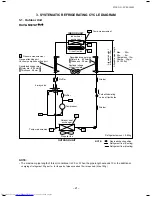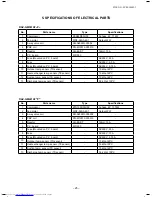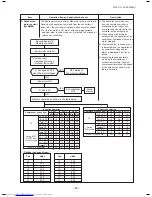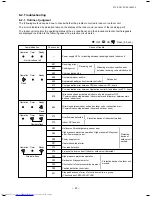
–
3
5
–
6-6-
5
.
Handling of Existing Pipe
When using the existing pipe, carefully check it for
the following:
Wall thickness (within the specified range)
Scratches and dents
Water, oil, dirt, or dust in the pipe
Flare looseness and leakage from welds
Deterioration of copper pipe and heat insulator
Cautions for using existing pipe
Do not reuse the flare to prevent gas leak.
Replace it with the supplied flare nut and then
process it to a flare.
Blow nitrogen gas or use an appropriate means to
keep the inside of the pipe clean.
If discolored oil or much residue is discharged,
wash the pipe.
Check welds, if any, on the pipe for gas leak.
When the pipe corresponds to any of the follow-
ing, do not use it. Install a new pipe instead.
The pipe has been open (disconnected from
indoor unit or outdoor unit) for a long period.
The pipe has been connected to an outdoor
unit
that does not use refrigerant R22, R
32
or
R407C.
The existing pipe must have a wall thickness equal
to or larger than the following thickness.
Never use any pipe with a wall thickness less than
these thicknesses due to insufficient pressure
capacity.
Reference outside diameter
(mm)
Ø
6
.
4
Ø
9
.
5
Ø1
2
.
7
Wall thickness
(mm)
0.8
0
.
8
0
.
8
Do not apply the refrigerator oil to the flare surface.
H
A
Piping necessary to change the flare nut/
machining size due to pipe compression.
1) Flare nut width: H
2) Flare machining size: A
(mm)
36
Ø19.0
29
Ø15.9
26
27
24
Ø12.7
22
Ø9.5
17
Ø6.4
Same
as above
Copper pipe
outer dia.
For R22
For R410A
,
R32
Same as above
(mm)
24.0
Ø19.0
19.7
Ø15.9
16.6
Ø12.7
13.2
Ø9.5
9.1
23.3
19.4
16.2
13.0
9.0
Ø6.4
Copper pipe
outer dia.
For R22
For R410A
,
R32
Becomes large a little for R410A
/R32
SVM-13072.indb 38
SVM-13072.indb 38
11/01/13 1:53 PM
11/01/13 1:53 PM
FILE NO. SVM-18042
-1
•
•
•
•
•
•
•
•
•
•
•
•
















































